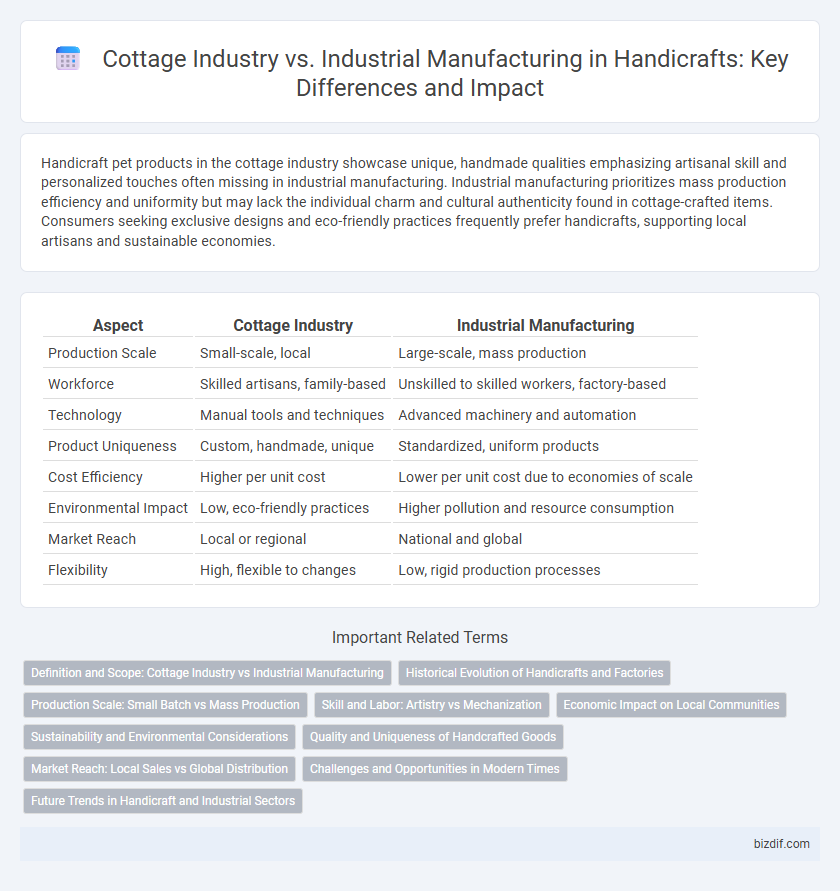Handicraft pet products in the cottage industry showcase unique, handmade qualities emphasizing artisanal skill and personalized touches often missing in industrial manufacturing. Industrial manufacturing prioritizes mass production efficiency and uniformity but may lack the individual charm and cultural authenticity found in cottage-crafted items. Consumers seeking exclusive designs and eco-friendly practices frequently prefer handicrafts, supporting local artisans and sustainable economies.
Table of Comparison
| Aspect | Cottage Industry | Industrial Manufacturing |
|---|---|---|
| Production Scale | Small-scale, local | Large-scale, mass production |
| Workforce | Skilled artisans, family-based | Unskilled to skilled workers, factory-based |
| Technology | Manual tools and techniques | Advanced machinery and automation |
| Product Uniqueness | Custom, handmade, unique | Standardized, uniform products |
| Cost Efficiency | Higher per unit cost | Lower per unit cost due to economies of scale |
| Environmental Impact | Low, eco-friendly practices | Higher pollution and resource consumption |
| Market Reach | Local or regional | National and global |
| Flexibility | High, flexible to changes | Low, rigid production processes |
Definition and Scope: Cottage Industry vs Industrial Manufacturing
Cottage industry refers to small-scale, home-based production where artisans create handicrafts using traditional methods, usually relying on manual skills and local materials. Industrial manufacturing involves large-scale production facilitated by advanced machinery, standardized processes, and factory settings, allowing mass production of goods. The scope of cottage industry is limited to localized markets with customized, unique products, whereas industrial manufacturing targets wide-scale distribution with uniform, high-volume output.
Historical Evolution of Handicrafts and Factories
Handicrafts originated as cottage industries where artisans produced goods by hand within rural homes, fostering unique cultural expressions and local traditions. The Industrial Revolution introduced mechanized factories, dramatically increasing production scale and standardizing designs but often reducing individual craftsmanship and creative diversity. This shift from manual, small-scale production to industrial manufacturing marks a significant evolution in the economic and social history of handicrafts worldwide.
Production Scale: Small Batch vs Mass Production
Cottage industry in handicraft typically involves small-batch production, emphasizing artisanal quality and customization for niche markets. Industrial manufacturing focuses on mass production, utilizing automated processes to achieve high volume and consistent output. The scale difference impacts flexibility, with cottage industry offering personalized craftsmanship and industrial manufacturing prioritizing efficiency and uniformity.
Skill and Labor: Artistry vs Mechanization
Cottage industry craftsmanship relies heavily on artisanal skill and manual labor, producing unique and intricately detailed handicrafts through traditional techniques passed down generations. Industrial manufacturing prioritizes mechanization and automation, enabling mass production with consistent quality but often lacking the nuanced artistry found in handcrafted goods. The contrast highlights the value of human creativity in cottage industries versus the efficiency and scale achievable through industrial processes.
Economic Impact on Local Communities
Cottage industries stimulate local economies by promoting small-scale production, preserving traditional skills, and creating employment opportunities within communities. Industrial manufacturing often centralizes production, leading to job losses in rural areas but generating higher output and economic growth on a larger scale. The balance between these sectors influences income distribution, local entrepreneurship, and the sustainability of cultural heritage in regional economies.
Sustainability and Environmental Considerations
Cottage industry in handicraft emphasizes sustainable practices by utilizing natural materials and traditional techniques that minimize waste and energy consumption. Industrial manufacturing often relies on mass production methods that increase carbon emissions, resource depletion, and environmental pollution. Sustainable handicraft promotes eco-friendly sourcing and smaller ecological footprints compared to large-scale industrial processes.
Quality and Uniqueness of Handcrafted Goods
Handcrafted goods in the cottage industry exhibit superior quality and uniqueness due to meticulous attention to detail and personalized craftsmanship, contrasting with the uniformity often found in industrial manufacturing. Artisans employ traditional techniques and natural materials, resulting in bespoke products that reflect cultural heritage and individual creativity. This distinctiveness enhances the value and authenticity of handicrafts, setting them apart from mass-produced items.
Market Reach: Local Sales vs Global Distribution
Cottage industries primarily focus on local sales, targeting niche markets with handcrafted, unique products valued for their cultural authenticity and artisanal quality. Industrial manufacturing enables global distribution through mass production, standardized processes, and extensive supply chains that meet high-volume demands. This scale advantage allows industrial goods to penetrate international markets more effectively than handicraft cottage products, which often rely on localized consumer bases.
Challenges and Opportunities in Modern Times
Cottage industries in handicraft face challenges such as limited scale, manual labor intensity, and difficulty accessing global markets, yet they benefit from opportunities in niche customization and sustainable production. Industrial manufacturing offers mass production and cost efficiency but struggles with maintaining authenticity and craftsmanship value. The modern market demands a balance, leveraging digital platforms to expand reach while preserving artisanal uniqueness and cultural heritage.
Future Trends in Handicraft and Industrial Sectors
The future of handicraft and industrial manufacturing involves integrating advanced technologies such as AI and IoT to enhance production efficiency while preserving artisanal quality. Emerging trends emphasize sustainable materials and personalized products, driving growth in eco-friendly cottage industries alongside automated industrial processes. Market demand is shifting towards hybrid models that combine traditional craftsmanship with digital innovation, fostering resilience and global competitiveness in both sectors.
Cottage industry vs Industrial manufacturing Infographic

 bizdif.com
bizdif.com